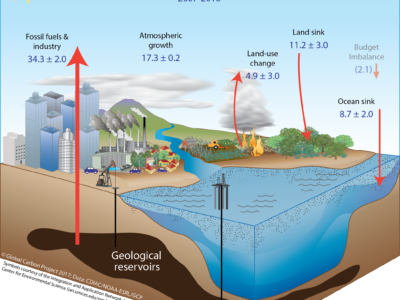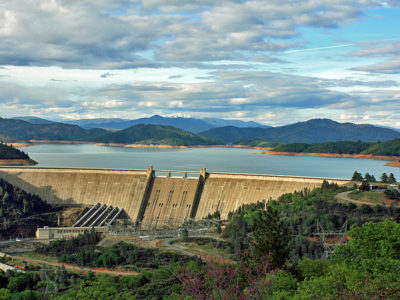Biodiversity & Species
In Defense of Live Carbon
Why Stopping Deforestation May be the Hardest and Most Important Part of the Climate Change Challenge
When contemplating the enormous challenge of global climate change, it is sometimes helpful to think about a simple model of the global carbon budget (see figure below). These admittedly reductionist schematics distinguish between sources, sinks, and reservoirs. Fossil hydrocarbons from the geological reservoir–call this dead carbon—are extracted and burned to generate energy, emitting vast amounts …
Continue reading “In Defense of Live Carbon”
CONTINUE READINGCould Genetically Modified Organisms Help Conserve Biodiversity?
The second in a series examines GMOs intentionally released into the wild
Last week, I introduced what I call “first generation” genetically modified organisms (GMOs) – altered bacteria for diverse, mostly indoor purposes – and “second generation” ones – GM crops and agricultural animals. Here, I describe third generation GMOs, which are those that would be intentionally placed into natural environments, where they would live, reproduce, and …
Continue reading “Could Genetically Modified Organisms Help Conserve Biodiversity?”
CONTINUE READINGClimate Change and Your Family’s Future
How much climate change will you see in your lifetime? How about your kids?
If you think about yourself and the two generations after you, a lot depends on your current age, whether you already have kids, etc. To keep this from getting too complicated, let’s focus on someone who was born in the US at the start of the millennium, in 2000. To simplify, I won’t specify gender …
Continue reading “Climate Change and Your Family’s Future”
CONTINUE READINGGenetically Modified Organisms Return to the International Policy Agenda
This first in a series begins by looking back at GMOs and environmental law
Although the big news in international biodiversity this week was the release of the summary of the first global assessment from a relatively new UN-affiliated body, the topic of another report warrants attention as well. Yesterday the International Union for Conservation of Nature (IUCN) published its findings on “the potential positive and negative impacts of synthetic …
Continue reading “Genetically Modified Organisms Return to the International Policy Agenda”
CONTINUE READINGTrump Administration’s Cold Water War With California Turns Hot
Feds’ Curious New Lawsuits Against State Water Board Likely Just the Opening Litigation Salvo
When it comes to California water policy, the federal-state relationship has always been both strained and challenging. That intergovernmental tension harkens back at least to the Reclamation Act of 1902. In section 8 of this iconic federal statute that transformed the American West, Congress declared that the federal government “shall proceed in conformity with” state …
Continue reading “Trump Administration’s Cold Water War With California Turns Hot”
CONTINUE READINGReviving LBJ’s Vision
Maybe What We Need is a Green Great Society
Talk about a Green New Deal is rife these days, but perhaps what we should be talking about instead is a Green Great Society. Actually, Lyndon Johnson’s vision of the great society was green from the get-go, so maybe we could just call for a renewed Great Society. What the Great Society is known for …
Continue reading “Reviving LBJ’s Vision”
CONTINUE READINGPublic Lands Watch: Final Changes to Sage Grouse Protections
BLM announces final version of revisions to protections for sage grouse on Western federal public lands
This blog post was drafted by Jamie T. Martinez. On March 15, the Trump administration finalized its plan to loosen protections on federal lands for the habitat of the greater sage-grouse, a near-threatened species that lives in sagebrush country across the western United States. The final plan amends the resource plans adopted in 2015 to …
Continue reading “Public Lands Watch: Final Changes to Sage Grouse Protections”
CONTINUE READINGMore on saving the monarch butterfly
Both federal and state action are needed, and it will take more than milkweed planting
Eric posted an excellent analysis last month of the desirability of protecting the monarch butterfly under California’s Endangered Species Act (CESA). I wanted to add a brief coda (as well as a couple of pictures) to his post, to emphasize the need for federal as well as state action, and to expand on the steps …
Continue reading “More on saving the monarch butterfly”
CONTINUE READINGSave the Monarch!
The plight of California’s iconic butterfly highlights the need to overhaul the state’s endangered species law
The Monarch butterfly is an iconic species for Californians. And it is heading rapidly towards extinction within the state, as the population counts for the California population this year indicate that butterfly numbers fell 86% in a single year, over a 99% drop since the 1980s, and the size of the population is now small …
Continue reading “Save the Monarch!”
CONTINUE READINGThe Power of the Purse
House Democrats have power to use appropriations process to stop Trump Administration environmental rollbacks
Dan has already posted about some of the big deregulatory steps the Trump Administration is likely to take in the next year. But the new Democratic majority in the House could have something to say about those steps, if they wanted to. Democrats will have even more leverage over spending bills than they had in …
Continue reading “The Power of the Purse”
CONTINUE READING










